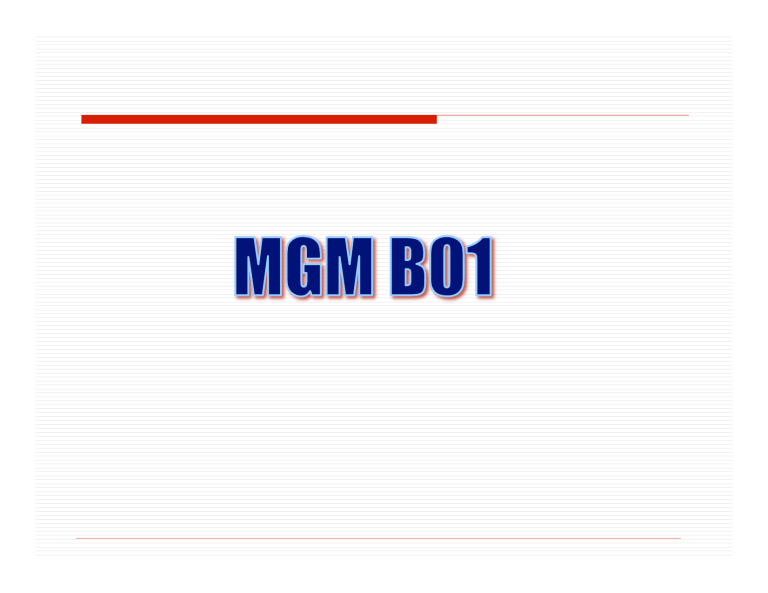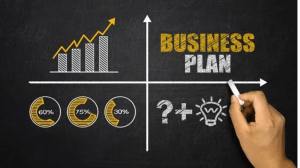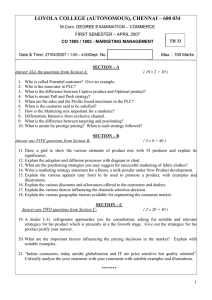
Today’s Agenda 1. 2. 3. 4. 5. 6. Course Overview What are Cases? Preparing Cases Participating in a Case based class Writing up Cases B04/MGM A01 overview Evaluation: Individual Evaluation: Class Discussion Individual Case write-ups (10 cases) 20 % 30 % Group Evaluation: Group Case presentation (2 cases) Group Project and Presentation 20 % 30 % Working with Cases • Analysing a Case • Case Coach Typical student comments I like using cases because I have a chance to voice my opinions and hear others; most of all, the discussions help me to sort through and understand what is going on in the case so I don’t miss anything The case discussions make events real –it is no longer just another name or act to be memorised, but the discussion brings the events and individuals to life I really like these discussions. One thing we do not learn very well in university is teamwork. College is essentially an individual thing – I study alone; take tests alone. However discussion helps me to learn from others I love this class ! It moves quickly and its fun. Its tough not to be right all the time though. I enjoy the case method because it forces me to think about issues and to take a stand in support of my opinion. It helps me think about why I believe what I do. It is hard for me sometimes to express my opinion in such a situation but I working on it here What I like best are the broader insights I gain and the different perspectives that are represented Case discussions are interesting and informative and are key to understanding marketing because views differ and those differences mirror reality Makes me think Participation Preparation: Reading the materials ahead of time, thinking about the reading and how it is connected to other course materials Speaking: Offering insights, observations, analysis, opinion; asking questions; and responding to other students’ comments Listening: to what others have to say, following the arguments and remembering the points Always bring copy of case, your individual report and your notes to class Reflection What Overall lessons do you take from this case? How would you change your case analysis after today’s class ? Your self evaluation Your goal for the next case B04/A01 OVERVIEW Definition of Marketing AMA, 1986 MARKETING IS . . . . the process of planning and executing the conception, pricing, promotion, and distribution of ideas, goods, and services to create exchanges that satisfy individual and organizational objectives. Utility and Marketing Time Utility Form Value that comes from satisfying human needs Place Possession From Production From Marketing The Central Idea ! The Marketing Mix C The Four Ps of the Marketing Mix Product Place C Price Promotion 5th P Summary of factors that affect an organization’s marketing program rces Soci al fo otion Prom Consumer es forc ory ulat Reg Prod uct Marketing program Technological forces Environmental forces Marketing’s first task: discovering consumer needs Organization’s marketing department Discover consumer needs Information about needs Potential consumers: The market Marketing’s second task: satisfying consumer needs Organization’s marketing department Discover consumer needs Information about needs Concepts for products Satisfy consumer needs Find the right combination of: • Product • Price • Promotion • Place Goods, services, ideas Potential consumers: The market What Marketers Do Look for Opportunities Consumer Competition Company (Uncontrollable 3Cs) Analyze Opportunities Segmenting Targeting Positioning (STP) Implement Positioning Product Price Promotion Place (Controllable 4Ps) The Marketer’s tasks 3 C’s STP Customer Competition Company Segmentation Targeting Positioning 4P’s Product Place Price Promotion Model of Consumer Behavior (CB) Marketing and Other Stimuli Buyer’s Black Box Product Choice Brand Choice Dealer Choice Buyer’s Response Purchase Timing Purchase Amount Influences on Consumer Behavior Consumer Characteristics Consumer Decision Processes Consumer Decisions Product Choice Brand Choice Dealer Choice Purchase Timing Purchase Amount Maslow’s Hierarchy of Needs Self Actualization (Self-development) Esteem Needs (self-esteem, status) Social Needs (sense of belonging, love) Safety Needs (security, protection) Physiological Needs (hunger, thirst) Higher level Consumer Decision Process Problem Recognition Information Search Alternative Evaluation Purchase Decision Postpurchase Behaviour Consumer Behavior Questions What do we need to know about consumers? Occupants: Who constitutes the market? Objects: What does the market buy? Occasions: When does the market buy? Outlets: Where does the market buy? Organization: Who participates in the buying? Objectives: Why does the market buy? Operations: How does the market buy? Key points for STP Effective marketing is customer driven. Step 1: What kinds of customers are there (segmentation)? Step 2: Target the customer segment that can deliver to you the most value in as unique a way as possible. Step 3: Choose a “position” that communicates your unique and differentiable position. Step 4: Evaluate market response and reposition. Perceptual Map of Beer Market (This slide shows only the products) • Budweiser Old Milwaukee • Meister Brau • Miller Beck’s • • Heineken • • • Coors Stroh’s • Michelob • • Old Milwaukee Light Miller Lite • Coors Light Perceptual Map of Beer Market cont’d (This slide shows only the attributes) Heavy Heavy Full Bodied Popular with Men Special Occasions Good Value Blue Collar Dining Out Premium Budget Premium Popular with Women Pale Color On a Budget Light Light Less Filling Perceptual Map of Beer Market cont’d (This slide shows both products & attributes) Heavy Heavy Full Bodied • Budweiser Old Milwaukee • Meister Brau • Good Value Miller Blue Collar • Popular with Men Beck’s • Stroh’s Budget • Heineken Special Occasions • Coors • Dining Out Premium Premium • Michelob • On a Budget • Pale Color Old Milwaukee Light Light Miller Lite Light • Coors Light Less Filling Popular with Women Example Input Data for MDPREF Vector Model Input matrix has attributes on rows and objects on columns Attractive Light Unreliable Plain Battery life Screen Keyboard Roomy Easy service Expandability Setup Common Value Preference B1 B2 B3 B3 B4 B5 B6 B7 B8 New 5.1 6.0 3.4 1.5 3.3 3.5 2.6 5.5 4.5 5.5 5.6 4.1 3.5 7.4 3.6 3.5 4.1 4.1 4.9 5.3 3.5 4.3 4.9 4.3 3.5 3.5 4.8 3.4 3.5 5.0 4.5 2.9 4.3 3.4 2.5 5.4 3.3 5.4 5.6 3.3 4.4 4.8 5.4 3.9 2.1 2.3 4.1 6.4 3.4 3.1 5.0 3.1 5.4 2.9 3.6 6.6 3.9 3.3 4.5 4.5 3.9 5.4 3.8 3.4 4.4 3.4 2.5 4.0 3.6 4.4 4.8 5.3 2.7 2.7 3.0 5.2 3.3 3.3 4.5 3.3 4.2 4.3 2.7 7.4 5.2 5.0 4.5 3.5 3.5 3.3 2.8 4.7 3.3 4.7 5.2 2.2 3.2 7.1 4.0 2.5 3.7 4.3 6.2 6.0 5.0 3.5 4.7 3.5 3.3 4.2 4.7 3.8 5.2 5.5 2.5 2.2 3.5 3.3 4.3 4.3 3.8 4.3 5.8 3.3 3.5 6.9 4.0 2.5 3.8 5.2 4.0 4.8 4.7 4.2 4.5 4.2 2.5 4.2 4.0 3.3 BCG Matrix BCG Matrix: 4 Contexts: Stars (Hi, Hi) Dogs (Lo, Lo) Question Marks (Hi, Lo) Cash Cows (Lo, Hi) Industry Growth Rate Industry Growth Rate (Y-axis) vs. Relative Market Share (X- axis) Question Marks Dogs Stars Cash Cows Relative Market Share Porter’s 5 Forces Threat of New Entrants Supplier Power Industry Attractiveness Industry Competitors Buyer Power Threat of Substitutes SWOT Internal External + Strengths Opportunities - Weaknesses Threats Break-even Analysis Total Revenue and Cost Higher Profit Area Break-Even Point Loss Area Total Revenue Curve Total Cost Curve Total Variable Costs Total Fixed Costs 0 Units of Production More Breakeven Analysis How much to produce to START making a profit ! Profit = Revenue – Cost Price x Quantity Unit Variable Cost x Quantity Fixed Cost + Variable Cost Π = Q.P – FC – Q.VC Breakeven => Π = 0 Q.P – FC – Q.VC = 0 Q(P-VC) = FC Q=FC/(P-VC) Q* Fixed Cost = Unit Price – Unit Variable Cost Pricing Company: Cost Plus Pricing Profit Pricing Competition: Competitive Parity Pricing Customer: Value Based Pricing Price Summary What user would have to pay to get equal benefits i.e perfect substitute 27.3 c Value to User SKIM Perceived Value Some fraction of actual value to user Consumer Surplus Price PENETRATION Producer Surplus 3.45 c 0 Variable Cost Prospect theory Subjective Value J Losses K Gains Reference point L The PLC, marketing objectives, and marketing mix Sales revenue or profit Stage of the product life cycle Introduction Growth Maturity Decline Total industry sales revenue + 0 – Total industry profit Marketing objective Gain Awareness Stress differentiation Maintain brand Harvesting, loyalty deletion Competition None Growing Many Reduced Product Usually one More versions Full product line Best sellers Price Skimming or penetration Penetration, deal Defend share, profit Profit Promotion Inform, educate Differentiate Differentiate, reminder Minimal Place (distribution) Limited More outlets Maximum outlets Fewer outlets Five categories and profiles of product adopters Diffusion of Innovation Origin: Rural Sociology – The way farmer adopted new agricultural innovations Certain characteristics of an innovation may serve to improve or detract from it’s chances of adoption by consumers (and the time frame over which adoption takes place). These are: •It’s perceived complexity •It’s compatibility in use with present behaviour patterns and complementary products •The ease with which it’s features (and especially it’s benefits) can be observed and communicated •The degree of risk – physical, financial and social – attached to adoption of the innovation in preference to existing products or procedures •The extent to which the innovation can be tried on a limited basis before being adopted on a large scale, permanent basis. Distribution channel Any set of firms or individuals who participate in the flow of products from producer to final user or consumer Make the sale of products more efficient by minimizing the number of sales contacts Number of interactions without intermediary M a n u f a c t u r e r s 4 x 4=16 interactions H o u s e h o l d s Number of interactions with intermediary M a n u f a c t u r e r s 4 + 4= 8 interactions Retailer H o u s e h o l d s Short vs. long channels Factors Short Channels Long Channels Market Business users Concentrated More knowledge req. Higher service needs Larger orders Consumers Dispersed Less knowledge req. Lower service needs Smaller orders Product Perishable Complex Expensive Durable Standardized Inexpensive Producer Has resources/ Lacks resources/ abilities abilities Broad line Control important Limited line Control not important Integrated marketing communications Traditional: Separate functions handled by experts in separate departments. Begin with organization’s products/services. IMC: All elements of promotional mix strategically integrated. All elements viewed from consumer perspective. IMC strategy Determine the optimal mix of options based on: Economic considerations Target market Effectiveness of brand building IMC strategy (cont’d) Focus on managing two dimensions Consistency Complementarity Ideal communications program Large number of communication options Sharing same core meaning Complementary advantages & disadvantages Complementarity in IMC Strengths inherent in one method counterbalance the disadvantages of another For example, TV advertising Competitive clutter Ad content and structure Consumer involvement “I forget the name of the product, but the jingle on TV goes something like ‘Yadee-dum-dee-rahte-dum-dee-rah-dee-dum.’” Structure other aspects of promotional mix to overcome these disadvantages Retrieval cues on coupon, in store, on packaging Push vs. pull promotional strategies Push strategy Manufacturer Flow of demand stimulation Wholesaler Pull strategy Manufacturer Flow of promotion; mainly personal selling directed to intermediaries Flow of demand stimulation Wholesaler Retailer Retailer Consumer Consumer Flow of promotion; mainly advertising directed to consumers Slice of Life Lifestyle Fantasy Mood/Image Musical Personality Symbol Technical expertise Scientific Evidence Testimonial Evidence Mission •Sales Goals •Adveritising Objectives Inform Persuade Remind 5 M’s of Advertising Style Tone Words Format Money Factors to Consider: •Stage in PLC •Market Share and consumer base •Competition and Clutter •Advertising Frequency •Product substitutability Message •Message Generation •Message evaluation and selection •Message execution •Social responsibility review Desirability Exclusiveness Believability Rational Positioning Emotional Positioning Measurement •Communication impact •Sales impact Media •Reach, frequency, impact •Major media types •Specific media vehicles •Media timing •Geographical media allocation Share Share Share Share of of of of expenditures voice mind and heart market Creative strategy: Types of appeals Cognitive “Rational” Affective “Emotional” Problem-solution Humour Demonstration Sex Product comparison Image or mood Testimonial Fear Slice of life




